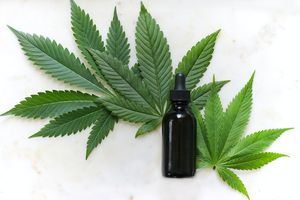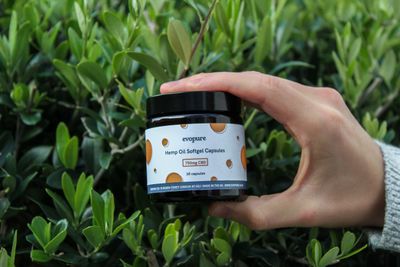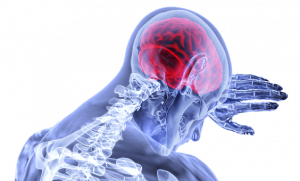Medical Cannabis: Difference between revisions
Ryan Scinta (talk | contribs) No edit summary |
(Edited the headings.) |
||
| (17 intermediate revisions by 5 users not shown) | |||
| Line 5: | Line 5: | ||
'''Top Contributors''' - {{Special:Contributors/{{FULLPAGENAME}}}} | '''Top Contributors''' - {{Special:Contributors/{{FULLPAGENAME}}}} | ||
</div> | </div> | ||
== | == Introduction == | ||
[[File:Cannabis oil.jpeg|right|frameless]] | |||
Cannabis sativa (C. sativa) is a flowering, fast growing shrub, commonly known as hemp, cannabis, or marijuana. It originates from Central Asia, and is widely distributed in temperate and tropical areas. For thousands of years, Cannabis sativa has been utilized as a medicine and for recreational and spiritual purposes.<ref>Maule WJ. Medical uses of marijuana (Cannabis sativa): fact or fallacy?. British journal of biomedical science. 2015 Jan 1;72(2):85-91.</ref> Phytocannabinoids are a family of compounds that are found in some flowering plants (such as cannabis plant), which is known for its psychotogenic and euphoric effects;<ref>Gülck T, Møller BL. Phytocannabinoids: origins and biosynthesis. Trends in Plant Science. 2020 Jul 6.</ref> the main psychotropic constituent of cannabis is Tetrahydrocannabinol (THC).<ref name=":2">PubChem [Internet]. Bethesda (MD): National Library of Medicine (US), National Center for Biotechnology Information; 2004-. PubChem Compound Summary for CID 16078, Dronabinol; [cited 2022 Jan. 29]. Available from: <nowiki>https://pubchem.ncbi.nlm.nih.gov/compound/Dronabinol</nowiki></ref> THC is one of the at least 113 recognized cannabinoids in C. sativa. The pharmacological effects of cannabinoids are a result of interactions between those compounds and cannabinoid receptors, CB1 and CB2, located in many parts of the human body<ref>Breijyeh,Z.;Jubeh,B.Bufo, S.A.; Karaman, R.; Scrano, L. Cannabis: A Toxin-Producing Plant with Potential Therapeutic Uses.Toxins 2021, 13, 117. Available from: <nowiki>https://res.mdpi.com/d_attachment/toxins/toxins-13-00117/article_deploy/toxins-13-00117.pdf</nowiki> | |||
(accessed 5.4.2021) | |||
</ref>. | |||
* Many people around the world believe that the drug should be readily available for both medical and recreational use; however governments around the world still have strict laws about its usage. | |||
* Each country has its own laws and regulations surrounding the drug; some places are more relaxed, whist others still believe the drug should be an illegal substance<ref>best in Au [https://bestinau.com.au/marijuana-laws-from-around-the-world-where-is-cannabis-legal/ Where is cannabis legal] Available from:https://bestinau.com.au/marijuana-laws-from-around-the-world-where-is-cannabis-legal/ (accessed 5.4.2021)</ref>. | |||
Cannabidiol (CBD), the major non-psychoactive constituent of ''Cannabis sativa'' L., has gained popularity as a potential treatment for certain conditions<ref name=":3">Argueta DA, Ventura CM, Kiven S, Sagi V, Gupta K. A balanced approach for cannabidiol use in chronic pain. Frontiers in pharmacology. 2020 Apr 30;11:561.</ref> See below). | |||
== Types of medicinal cannabis products == | |||
[[File:Cannabis pills.jpeg|right|frameless|400x400px]] | |||
Cannabis is a complex plant comprising more than 500 constituents, including approximately 100 cannabinoids. The main active ingredients used for medical purposes are tetrahydrocannabinol (THC) and cannabidiol (CBD). THC is the psychoactive part of cannabis that produces a ‘high’, and has been used to treat symptoms such as nausea, pain and muscle spasticity. CBD has no psychoactive properties, and has been used to treat several inflammatory disorders and epilepsy.<ref name=":3" /> | |||
Medicinal cannabis products can come in three main forms: | |||
# Pharmaceutical: Natural and synthetic medical-grade products with standardized content. The three main products are: | |||
#* Dronabinol: Synthetic form of THC<ref name=":2" /> | |||
#* Nabilone: Synthetic form of THC | |||
#* Nabiximols: Chemically pure 50:50 mixture of TCH and CBD. | |||
# Medicinal-grade herbal cannabis: Produced and processed in controlled standard conditions to a medical grade, free of adulterants, higher levels of CBD and other cannabinoids, and contains lower levels of THC. This is provided in herbal form, or processed as an oil, balm, capsule or pill. | |||
# Herbal cannabis on the illegal market: Potentially unstable THC and CBD, and may contain adulterants.<ref name=":0">RACGP [https://www.racgp.org.au/advocacy/position-statements/view-all-position-statements/clinical-and-practice-management/medical-cannabis Medicinal Cannabis] Available from:https://www.racgp.org.au/advocacy/position-statements/view-all-position-statements/clinical-and-practice-management/medical-cannabis (accessed 5.4.2021)</ref> | |||
== | == The Evidence == | ||
[[File:Evidence.jpeg|right|frameless]] | |||
At present, the evidence base for the use of medicinal cannabis products is limited.<ref>O’Brien K. Medicinal cannabis: Issues of evidence. European Journal of Integrative Medicine. 2019 Jun 1;28:114-20.</ref> The current evidence base for the use of medicinal cannabis products is heterogeneous, comprising a small number of randomized clinical trials when stratified by condition, symptom or intervention type.<ref>Whiting PF, Wolff RF, Deshpande S, Di Nisio M, Duffy S, Hernandez AV. Cannabinoids for medical use. JAMA [Internet]. 2015; 313 (24): 2456.</ref> <ref name=":0" />These studies are of variable quality, including those with high risk of bias (eg incomplete outcome data), low statistical power, and short follow-up time. | |||
* Recent reviews and analyses indicate there may be some therapeutic benefits of medicinal cannabis products in certain conditions but further research on the treatment efficacy and longer term side effects are warranted. | |||
* Currently, most research and evidence on medicinal cannabis products have come from five clinical conditions: [[Multiple Sclerosis (MS)|multiple sclerosis]]; [[Palliative Care Competence Framework for Physiotherapists|palliative care]]; [[epilepsy]]; nausea and vomiting; and [[Chronic Pain|chronic non-cancer pain]].<ref name=":0" /> | |||
* As there is limited scientific evidence to support the use of medicinal cannabis in most conditions, and in many cases the evidence is for its use together with other medicines, it should be used only when approved treatments have been tried and have failed to manage conditions and symptoms.<ref name=":1">Aust Government [https://www.tga.gov.au/publication/guidance-use-medicinal-cannabis-australia-patient-information Guidance on medicinal cannabis] Available from:https://www.tga.gov.au/publication/guidance-use-medicinal-cannabis-australia-patient-information (accessed 5.4.2021)</ref> | |||
=== Chronic Pain === | |||
The International Association for the Study of Pain (IASP) taskforce looked at all the available research published in peer-reviewed journals on the use of medicinal cannabis for pain management, from preclinical studies to human trials. | |||
== | They concluded overall the studies’ “quality, rigour, and transparency of reporting” of benefits and harms needs to be improved across the board. The IASP taskforce demands higher quality data, for example through randomized controlled trials, to determine the safety and efficacy of using medicinal cannabis for pain<ref>IASP Position Statement on the Use of Cannabinoids to Treat Pain Available from:https://www.iasp-pain.org/PublicationsNews/NewsDetail.aspx?ItemNumber=11145&navItemNumber=643 (accessed 5.4.2021) | ||
</ref> | |||
=== Multiple sclerosis === | |||
Anout 50% of the studies in a recent systematic reviews showed that medicinal cannabis products may be effective for pain, spasticity, sleep and bladder function. The other half had inconclusive results.<ref name=":0" /> | |||
=== Epilepsy === | |||
A number of studies have found low evidence for the use of medicinal cannabis products for the treatment of paediatric epilepsy, and for patients up to aged 25 years, especially when first-line treatments (ie anti-epileptic drugs) have been found to be ineffective. The numbers needed to treat are as follows: | |||
* 50% or greater reduction in seizure frequency: 8 | |||
* Complete seizure freedom: 17 | |||
* Improvement in parental-reported [[Quality of Life|quality of life]]: 5 | |||
* The numbers needed to harm for any adverse event was 3, and serious adverse event was 23. | |||
=== Palliative care === | |||
The use of medicinal cannabis products in palliative care is currently unclear. | |||
[[File:Pain stress brain.png|right|frameless]] | |||
=== Nausea and vomiting === | |||
A small number of studies have found relief of nausea and vomiting in patients with [[Oncology|cancer]] who are undergoing [[Chemotherapy Side Effects and Syndromes|chemotherapy]]; however, the evidence is lacking and some were compared with now out-of-date practices. | |||
( | === Chronic non-cancer pain === | ||
There is some evidence available for the treatment of [[Neuropathic Pain|neuropathic pain]] using medicinal cannabis products; however, the magnitude of effect is small. One systematic review found that the numbers needed to treat was 22 for a 30% reduction and 26 for a 50% reduction in self-reported pain intensity<ref name=":0" /> | |||
== Side Effects == | |||
Like all prescription medicines, medicinal cannabis products can have side effects. The extent of effects of these can vary with the type of medicinal cannabis product and between individuals. | |||
* In general, the side effects of CBD-rich products are less than those for high-THC products, but because the required doses for CBD can be quite high in conditions such as pediatric epilepsies, a proportion of patients encounter side-effects with these CBD doses. | |||
* The known side-effects from medicinal cannabis treatment (both CBD and THC) include fatigue and sedation, vertigo, nausea and vomiting, fever, decreased or increased appetite, dry mouth, and diarrhea. | |||
* THC (and products high in THC) have been associated with convulsions, feeling high or feeling dissatisfied, [[depression]], confusion, hallucinations, paranoid delusions, psychosis, and cognitive distortion (having thoughts that are not true)<ref name=":1" />. | |||
( | == Relevance to Physical Therapy == | ||
Physiotherapists should be able to educate patients on the reported benefits of cannabis (eg chronic pain, MS, spasticity, and chemotherapy-induced nausea and vomiting) as well as potential adverse effects. Also, trends in the medical use of cannabis can be studied in relation to the extant laws of the country of practice to understand what is allowed in a region concerning the use of medicinal cannabis. | |||
== Summary of Evidence by Condition == | |||
{| class="wikitable" | |||
!Condition | |||
!Products | |||
!Current evidence quality | |||
|- | |||
! colspan="3" |Multiple sclerosis | |||
|- | |||
|Pain | |||
|Dronabinol, THC extracts | |||
|Low to high and inconsistent | |||
|- | |||
|Disability and its progression | |||
| | |||
|None | |||
|- | |||
|Spasticity | |||
|Nabiximols and THC:CBD | |||
|Low and inconsistent | |||
|- | |||
|Bladder function | |||
| | |||
|None | |||
|- | |||
|Ataxia and tremor | |||
| | |||
|None | |||
|- | |||
|Sleep | |||
| | |||
|None | |||
|- | |||
|Quality of life | |||
|Nabiximols and THC:CBD | |||
|Low and inconsistent | |||
|- | |||
! colspan="3" |Epilepsy | |||
|- | |||
| rowspan="4" |To reduce and/or eliminate the number of seizures | |||
|CBD when used in conjunction with anti-epileptic drugs | |||
|Low to very low | |||
|- | |||
|Oral cannabis extracts (OCEs) | |||
|Very low | |||
|- | |||
|CBD:THC | |||
|Very low | |||
|- | |||
|Cannabis sativa | |||
|Very low | |||
|- | |||
| rowspan="5" |Quality of life | |||
|CBD | |||
|Low | |||
|- | |||
|Oral cannabis extracts (OCEs) | |||
|Very low | |||
|- | |||
|CBD:THC | |||
|Very low | |||
|- | |||
|Cannabis sativa | |||
|Very low | |||
|- | |||
|THC | |||
|Very low | |||
|- | |||
! colspan="3" |Palliative care | |||
|- | |||
|Alzheimer's disease | |||
|Dronabinol | |||
|Unclear | |||
|- | |||
| rowspan="3" |Advanced cancer symptom control | |||
|Dronabinol, THC:CBD, THC | |||
|Unclear but some evidence against use | |||
|- | |||
|Cannabis sativa | |||
|Unclear | |||
|- | |||
|Nabilone | |||
|Unclear | |||
|- | |||
! colspan="3" |Nausea and vomiting | |||
|- | |||
| rowspan="7" | | |||
|Dronabinol | |||
|Low to moderate | |||
|- | |||
|Nabilone | |||
|Very low to moderate | |||
|- | |||
|THC | |||
|Low, insufficient evidence | |||
|- | |||
|Levonantradol | |||
|Low to moderate | |||
|- | |||
|THC:CBD | |||
|Insufficient evidence | |||
|- | |||
|Cannabis sativa extract | |||
|Unclear | |||
|- | |||
|Naximols | |||
|Insufficient evidence | |||
|- | |||
! colspan="3" |Chronic non-cancer pain | |||
|- | |||
| rowspan="7" | | |||
|Nabiximols | |||
|Moderate to high | |||
|- | |||
|Dronabinol | |||
|Low to moderate | |||
|- | |||
|Nabilone | |||
|Very low | |||
|- | |||
|Cannabis sativa | |||
|Very low | |||
|- | |||
|THC extract | |||
|Moderate | |||
|- | |||
|THC:CBD extract | |||
|Low to moderate | |||
|- | |||
|Ajulemic acid | |||
|Very low | |||
|} | |||
Nabiximols is a TGA-registered medicine, under the tradename Sativex. It is a standardised extract of cannabis, containing roughly equal amounts of THC and CBD. | |||
Dronabinol is a synthetic form of THC. | |||
Nabilone is a cannabinoid synthesised in the laboratory, and has actions similar to THC although its chemical structure is different. | |||
Ajulemic acid is a cannabinoid synthesised in the laboratory. It is similar to a breakdown product (metabolite) of THC but does not have psychoactive properties.<ref name=":1" /> | |||
==References== | |||
<references /> | <references /> | ||
[[Category:Bellarmine_Student_Project]] | [[Category:Bellarmine_Student_Project]] | ||
[[Category:Global Health]] | |||
[[Category:Pharmacology]] | |||
[[Category:Pain]] | |||
Latest revision as of 17:07, 4 February 2022
Original Editors -Mark Wojda from Bellarmine University's Pathophysiology of Complex Patient Problems project.
Top Contributors - Ryan Scinta, Lucinda hampton, Elaine Lonnemann, Kim Jackson, Ryan Barry, WikiSysop, Mark Wojda and Joseph Ayotunde Aderonmu
Introduction[edit | edit source]
Cannabis sativa (C. sativa) is a flowering, fast growing shrub, commonly known as hemp, cannabis, or marijuana. It originates from Central Asia, and is widely distributed in temperate and tropical areas. For thousands of years, Cannabis sativa has been utilized as a medicine and for recreational and spiritual purposes.[1] Phytocannabinoids are a family of compounds that are found in some flowering plants (such as cannabis plant), which is known for its psychotogenic and euphoric effects;[2] the main psychotropic constituent of cannabis is Tetrahydrocannabinol (THC).[3] THC is one of the at least 113 recognized cannabinoids in C. sativa. The pharmacological effects of cannabinoids are a result of interactions between those compounds and cannabinoid receptors, CB1 and CB2, located in many parts of the human body[4].
- Many people around the world believe that the drug should be readily available for both medical and recreational use; however governments around the world still have strict laws about its usage.
- Each country has its own laws and regulations surrounding the drug; some places are more relaxed, whist others still believe the drug should be an illegal substance[5].
Cannabidiol (CBD), the major non-psychoactive constituent of Cannabis sativa L., has gained popularity as a potential treatment for certain conditions[6] See below).
Types of medicinal cannabis products[edit | edit source]
Cannabis is a complex plant comprising more than 500 constituents, including approximately 100 cannabinoids. The main active ingredients used for medical purposes are tetrahydrocannabinol (THC) and cannabidiol (CBD). THC is the psychoactive part of cannabis that produces a ‘high’, and has been used to treat symptoms such as nausea, pain and muscle spasticity. CBD has no psychoactive properties, and has been used to treat several inflammatory disorders and epilepsy.[6]
Medicinal cannabis products can come in three main forms:
- Pharmaceutical: Natural and synthetic medical-grade products with standardized content. The three main products are:
- Dronabinol: Synthetic form of THC[3]
- Nabilone: Synthetic form of THC
- Nabiximols: Chemically pure 50:50 mixture of TCH and CBD.
- Medicinal-grade herbal cannabis: Produced and processed in controlled standard conditions to a medical grade, free of adulterants, higher levels of CBD and other cannabinoids, and contains lower levels of THC. This is provided in herbal form, or processed as an oil, balm, capsule or pill.
- Herbal cannabis on the illegal market: Potentially unstable THC and CBD, and may contain adulterants.[7]
The Evidence[edit | edit source]
At present, the evidence base for the use of medicinal cannabis products is limited.[8] The current evidence base for the use of medicinal cannabis products is heterogeneous, comprising a small number of randomized clinical trials when stratified by condition, symptom or intervention type.[9] [7]These studies are of variable quality, including those with high risk of bias (eg incomplete outcome data), low statistical power, and short follow-up time.
- Recent reviews and analyses indicate there may be some therapeutic benefits of medicinal cannabis products in certain conditions but further research on the treatment efficacy and longer term side effects are warranted.
- Currently, most research and evidence on medicinal cannabis products have come from five clinical conditions: multiple sclerosis; palliative care; epilepsy; nausea and vomiting; and chronic non-cancer pain.[7]
- As there is limited scientific evidence to support the use of medicinal cannabis in most conditions, and in many cases the evidence is for its use together with other medicines, it should be used only when approved treatments have been tried and have failed to manage conditions and symptoms.[10]
Chronic Pain[edit | edit source]
The International Association for the Study of Pain (IASP) taskforce looked at all the available research published in peer-reviewed journals on the use of medicinal cannabis for pain management, from preclinical studies to human trials.
They concluded overall the studies’ “quality, rigour, and transparency of reporting” of benefits and harms needs to be improved across the board. The IASP taskforce demands higher quality data, for example through randomized controlled trials, to determine the safety and efficacy of using medicinal cannabis for pain[11]
Multiple sclerosis[edit | edit source]
Anout 50% of the studies in a recent systematic reviews showed that medicinal cannabis products may be effective for pain, spasticity, sleep and bladder function. The other half had inconclusive results.[7]
Epilepsy[edit | edit source]
A number of studies have found low evidence for the use of medicinal cannabis products for the treatment of paediatric epilepsy, and for patients up to aged 25 years, especially when first-line treatments (ie anti-epileptic drugs) have been found to be ineffective. The numbers needed to treat are as follows:
- 50% or greater reduction in seizure frequency: 8
- Complete seizure freedom: 17
- Improvement in parental-reported quality of life: 5
- The numbers needed to harm for any adverse event was 3, and serious adverse event was 23.
Palliative care[edit | edit source]
The use of medicinal cannabis products in palliative care is currently unclear.
Nausea and vomiting[edit | edit source]
A small number of studies have found relief of nausea and vomiting in patients with cancer who are undergoing chemotherapy; however, the evidence is lacking and some were compared with now out-of-date practices.
Chronic non-cancer pain[edit | edit source]
There is some evidence available for the treatment of neuropathic pain using medicinal cannabis products; however, the magnitude of effect is small. One systematic review found that the numbers needed to treat was 22 for a 30% reduction and 26 for a 50% reduction in self-reported pain intensity[7]
Side Effects[edit | edit source]
Like all prescription medicines, medicinal cannabis products can have side effects. The extent of effects of these can vary with the type of medicinal cannabis product and between individuals.
- In general, the side effects of CBD-rich products are less than those for high-THC products, but because the required doses for CBD can be quite high in conditions such as pediatric epilepsies, a proportion of patients encounter side-effects with these CBD doses.
- The known side-effects from medicinal cannabis treatment (both CBD and THC) include fatigue and sedation, vertigo, nausea and vomiting, fever, decreased or increased appetite, dry mouth, and diarrhea.
- THC (and products high in THC) have been associated with convulsions, feeling high or feeling dissatisfied, depression, confusion, hallucinations, paranoid delusions, psychosis, and cognitive distortion (having thoughts that are not true)[10].
Relevance to Physical Therapy[edit | edit source]
Physiotherapists should be able to educate patients on the reported benefits of cannabis (eg chronic pain, MS, spasticity, and chemotherapy-induced nausea and vomiting) as well as potential adverse effects. Also, trends in the medical use of cannabis can be studied in relation to the extant laws of the country of practice to understand what is allowed in a region concerning the use of medicinal cannabis.
Summary of Evidence by Condition[edit | edit source]
| Condition | Products | Current evidence quality |
|---|---|---|
| Multiple sclerosis | ||
| Pain | Dronabinol, THC extracts | Low to high and inconsistent |
| Disability and its progression | None | |
| Spasticity | Nabiximols and THC:CBD | Low and inconsistent |
| Bladder function | None | |
| Ataxia and tremor | None | |
| Sleep | None | |
| Quality of life | Nabiximols and THC:CBD | Low and inconsistent |
| Epilepsy | ||
| To reduce and/or eliminate the number of seizures | CBD when used in conjunction with anti-epileptic drugs | Low to very low |
| Oral cannabis extracts (OCEs) | Very low | |
| CBD:THC | Very low | |
| Cannabis sativa | Very low | |
| Quality of life | CBD | Low |
| Oral cannabis extracts (OCEs) | Very low | |
| CBD:THC | Very low | |
| Cannabis sativa | Very low | |
| THC | Very low | |
| Palliative care | ||
| Alzheimer's disease | Dronabinol | Unclear |
| Advanced cancer symptom control | Dronabinol, THC:CBD, THC | Unclear but some evidence against use |
| Cannabis sativa | Unclear | |
| Nabilone | Unclear | |
| Nausea and vomiting | ||
| Dronabinol | Low to moderate | |
| Nabilone | Very low to moderate | |
| THC | Low, insufficient evidence | |
| Levonantradol | Low to moderate | |
| THC:CBD | Insufficient evidence | |
| Cannabis sativa extract | Unclear | |
| Naximols | Insufficient evidence | |
| Chronic non-cancer pain | ||
| Nabiximols | Moderate to high | |
| Dronabinol | Low to moderate | |
| Nabilone | Very low | |
| Cannabis sativa | Very low | |
| THC extract | Moderate | |
| THC:CBD extract | Low to moderate | |
| Ajulemic acid | Very low | |
Nabiximols is a TGA-registered medicine, under the tradename Sativex. It is a standardised extract of cannabis, containing roughly equal amounts of THC and CBD.
Dronabinol is a synthetic form of THC.
Nabilone is a cannabinoid synthesised in the laboratory, and has actions similar to THC although its chemical structure is different.
Ajulemic acid is a cannabinoid synthesised in the laboratory. It is similar to a breakdown product (metabolite) of THC but does not have psychoactive properties.[10]
References[edit | edit source]
- ↑ Maule WJ. Medical uses of marijuana (Cannabis sativa): fact or fallacy?. British journal of biomedical science. 2015 Jan 1;72(2):85-91.
- ↑ Gülck T, Møller BL. Phytocannabinoids: origins and biosynthesis. Trends in Plant Science. 2020 Jul 6.
- ↑ 3.0 3.1 PubChem [Internet]. Bethesda (MD): National Library of Medicine (US), National Center for Biotechnology Information; 2004-. PubChem Compound Summary for CID 16078, Dronabinol; [cited 2022 Jan. 29]. Available from: https://pubchem.ncbi.nlm.nih.gov/compound/Dronabinol
- ↑ Breijyeh,Z.;Jubeh,B.Bufo, S.A.; Karaman, R.; Scrano, L. Cannabis: A Toxin-Producing Plant with Potential Therapeutic Uses.Toxins 2021, 13, 117. Available from: https://res.mdpi.com/d_attachment/toxins/toxins-13-00117/article_deploy/toxins-13-00117.pdf (accessed 5.4.2021)
- ↑ best in Au Where is cannabis legal Available from:https://bestinau.com.au/marijuana-laws-from-around-the-world-where-is-cannabis-legal/ (accessed 5.4.2021)
- ↑ 6.0 6.1 Argueta DA, Ventura CM, Kiven S, Sagi V, Gupta K. A balanced approach for cannabidiol use in chronic pain. Frontiers in pharmacology. 2020 Apr 30;11:561.
- ↑ 7.0 7.1 7.2 7.3 7.4 RACGP Medicinal Cannabis Available from:https://www.racgp.org.au/advocacy/position-statements/view-all-position-statements/clinical-and-practice-management/medical-cannabis (accessed 5.4.2021)
- ↑ O’Brien K. Medicinal cannabis: Issues of evidence. European Journal of Integrative Medicine. 2019 Jun 1;28:114-20.
- ↑ Whiting PF, Wolff RF, Deshpande S, Di Nisio M, Duffy S, Hernandez AV. Cannabinoids for medical use. JAMA [Internet]. 2015; 313 (24): 2456.
- ↑ 10.0 10.1 10.2 Aust Government Guidance on medicinal cannabis Available from:https://www.tga.gov.au/publication/guidance-use-medicinal-cannabis-australia-patient-information (accessed 5.4.2021)
- ↑ IASP Position Statement on the Use of Cannabinoids to Treat Pain Available from:https://www.iasp-pain.org/PublicationsNews/NewsDetail.aspx?ItemNumber=11145&navItemNumber=643 (accessed 5.4.2021)










